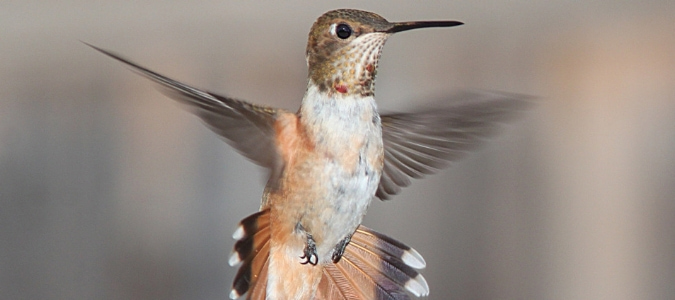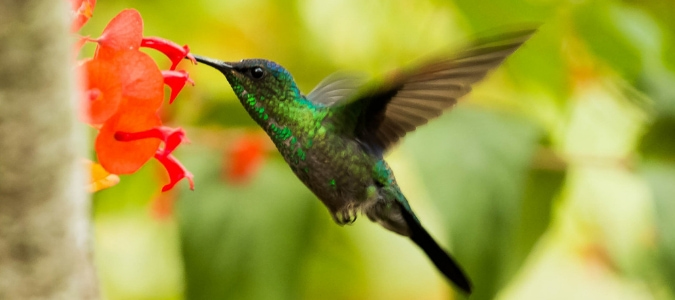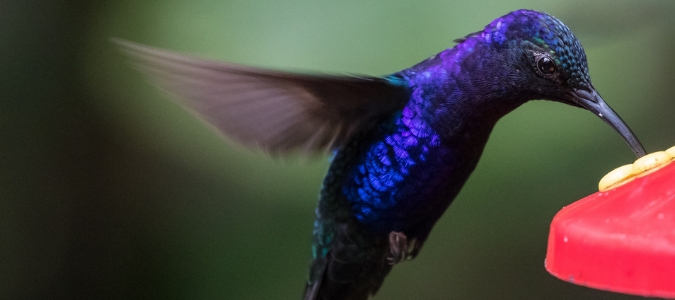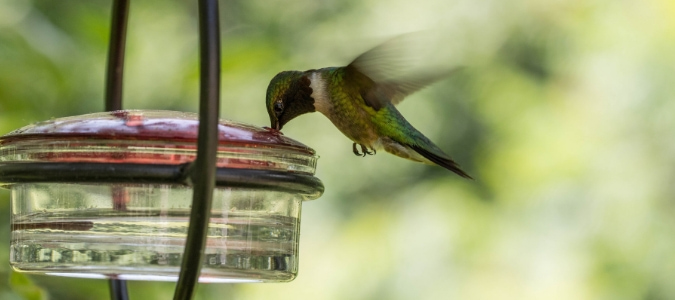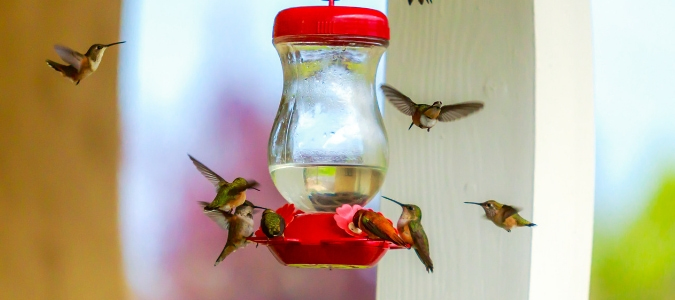
If you are like many homeowners, you love hummingbirds. Watching them flitter and flutter around your yard is captivating. Seeing them hover in place as they enjoy the nectar you’ve left out for them is even better. Their speed and size and almost unnatural presence are awe-inspiring.
So, when your neighbor told you that you were stopping them from migrating by leaving out your feeders in the fall, your first instinct was to rush out and take them down. After all, you don’t want to do anything that could possibly harm these beautiful creatures.
Luckily, you decided to do some research first. Smart move on your part.
Why?
Because what your neighbor told you is a myth, and it’s one that lawn technicians hear all the time.
Leaving feeders out does not stop migration. Quite the opposite, in fact. If you leave a hummingbird feeder out while these birds are migrating, you’re actually providing these creatures with a fantastic opportunity to refuel on their journey.
Moreover, keeping a feeder up longer in the fall can serve to help out any hummingbirds that end up migrating later than normal for whatever reason. This is important because the natural nectar and bugs hummingbirds typically eat may be gone by the time these late migraters make their move, and your feeder can sustain these beautiful birds until they get further south.
So, knowing all this, when should you take your feeder down?
The general rule of thumb is that you can remove feeders for the year if you don’t see any hummingbirds for about 7-10 days in the fall. Typically, that’s a sign that hummingbirds have moved on and won’t be back until next season.
Truly dedicated birders often decide to keep a journal or calendar to keep track of when hummingbirds arrive and leave each year. This is probably the best way to know for sure, since feeding patterns can vary not only by region for these birds but even by individual neighborhoods and yards.
Of course, if this is relatively new to you, it probably begs another question: when, roughly speaking, should you be watching for hummingbirds to leave?
When Do Hummingbirds Leave For Migration? Top Factors
In the world, there are more than 300 species of hummingbirds, but only about a dozen types spend their summers in the U.S. Even with this relatively small number of species, though, migration periods vary quite a bit.
Here in the southern states, some species will start heading south as early as July, while others don’t leave until November. A few even stay year-round in coastal areas.
However, this migration pattern isn’t 100 percent set. There are a number of factors that can impact when hummingbirds migrate.
Decreasing Daylight
Did you know that as daylight decreases seasonally, hummingbird hormones physically change? It’s true. Their bodies are telling them to eat more to prepare for their long, upcoming flight, and that’s exactly what they do—raising their body weight by anywhere from 25 to 40 percent.
So, when an area experiences fewer daylight hours, it causes hummingbirds to prepare to leave.
Fewer Natural Sources Of Food
When nectar-producing flowers become fewer in number and the insect population starts to hunker down for cooler weather, hummingbirds take this as a sign to move on.
Migration Distance
Seems obvious, right? If a particular species has a longer migration trip to make, it’s going to take them more time. In order to reach their destination before the weather gets too cold, they have to leave earlier.
Age And Gender
It takes a while for younger hummingbirds to build up their strength to the point where they can handle a long, arduous migration, so they tend to leave later than more mature adults. Additionally, males in some hummingbird species leave a couple of days before females so that they can arrive early and claim their territory for mating season.
Bad Weather
If the weather is particularly troublesome during migration, hummingbirds may stop for as much as a week or two until things clear up.
When Do Hummingbirds Come Back In Spring?
While we’re on the subject of migration, the next question people usually ask is when they should expect hummingbirds to return the following year.
Again, it varies. Some species start heading north as early as January, while others wait until later in the year. This means that the time they arrive in your neck of the woods will depend both on the species and where you’re located.
Using Texas as an example, most people can expect to see hummingbirds appear sometime between the middle of March and the middle of May.
Making sure your feeder is already up and established before they arrive can encourage them to nest in your yard or close by.
What Time Of Day Do Hummingbirds Feed?
When do hummingbirds eat during the day? When don’t they eat?!
Unlike people, who are generally advised not to snack between meals, some hummingbirds eat as often as every 10 minutes.
It makes sense, if you think about it. After all, you’ve seen how fast these little guys move, right? Flapping your wings that fast takes a lot of energy.
Because of this, hummingbirds eat about half their body weight in sugar each day and may consume hundreds (yes, that’s right, hundreds) of fruit flies.
Can you imagine going up against one of them in an eating contest?
All of this being said, generally, the best time to catch hummingbirds eating is early in the morning or in the evening before they go to sleep for the night. Essentially, these are the times when they “tank up” to replenish their energy stores, so you’re more likely to notice them because they’ll be eating for longer.
What does this mean if you have feeders?
Basically, you should make sure they have plenty of nectar available before these times if you want to attract hummingbirds.
When To Start Feeding Hummingbirds: Experts Weigh In
So, now that you know when hummingbirds arrive and leave throughout the year and what times of day they tend to eat, the next question is when you should start feeding them.
You might think the start of the migration period is a good time, but it’s actually smarter—and more helpful—to have your feeders up before this. Why? Because even though it seems like they should know better, often some hummingbirds will arrive each year before the nectar-producing flowers they like to eat are in bloom in your area.
Whoops.
In order for these eager beavers to survive, they need some kind of food source to sustain them. This is where you can play hero if your feeder is already up and ready. Additionally, if they have nowhere else to go because other food sources just don’t exist, they’re far more likely to hang around your yard.
So, when exactly should you put your feeders up?
Take a look at the migration schedule for your area (or your birding journal if you keep one). Subtract two weeks.
The date you come up with is (roughly) when you should have your feeders out and ready.
Now, keep in mind that these feeders are just in case you get early arrivals. They may get used. They may not. But having them out will ensure that no hummingbird goes hungry while they wait for nature to catch up to them.
Beyond Feeders: How To Make Your Yard A Food Source For Hummingbirds
So far, we’ve mostly just talked about feeders in this post. They definitely have their uses. Not only are they good at attracting hummingbirds, as mentioned above, they also provide a valuable food source when nature isn’t able to do so.
Before we talk about ways to encourage hummingbirds to stick around, we should mention that feeders don’t only attract hummingbirds. Common yard pests, including bees and ants have been known to feast on the nectar. Some homeowners even report that rats, bats, racoons and squirrels have been seen stealing from hummingbird feeders. Although insects don’t tend to interfere with the hummingbirds enjoying your feeders, there are some tactics that can work to discourage these creatures from creating a mess. Bee guards and hanging feeders with fishing line can discourage some of these pests from snacking on nectar. Animals may require a species-specific approach. The good news is that most of these creatures will come out at night, so they also won’t interfere with your hummingbirds eating. In extreme cases, you can bring in your feeder when darkness falls and put the feeder back up when you wake up.
There are a few other things you can do to encourage hummingbirds to visit as well.
Cultivate Hummingbird-Friendly Plants
Check to see which species are viable in your specific area. Lawn and landscape experts can help you identify and plant the types which will work well for your soil, sun conditions and microclimate.
Add A Water Feature
As much as they like nectar, hummingbirds need plain old water as well. Gently running water is ideal for these birds. Keep in mind that you’ll want to make sure water isn’t left standing, as that can encourage mosquitoes to breed. Do hummingbirds eat mosquitoes? Yes, they will, but most homeowners would choose to supply the nectar and discourage the mosquitoes in their yards, if given the option.
Encourage Beneficial Bugs
Not advice you typically get, right? But remember that insects make up a substantial portion of hummingbirds’ diets. You’re going to want to use insect-pollinated plants and hang a basket of overripe fruit close to your feeders if you want to draw in fruit flies that are a favorite for hummingbirds.
ABC Can Turn Your Yard Into A Hummingbird Oasis
Heading out to the store and getting a feeder isn’t that big of a deal, but if you decide to implement some of these other changes to your yard, it can take a lot of time and effort—something many people just don’t have. If you’re ready to learn more about what you can do to get hummingbirds in Texas to stop by, get in touch with ABC Home & Commercial Services. Our landscape designers and lawn professionals have assisted countless homeowners just like you, and they know exactly what it takes to bring hummingbirds to your yard. From choosing the right Texas landscaping plants to picking hummingbird-friendly colors and managing pest issues, ABC has the experience and know-how you need.
